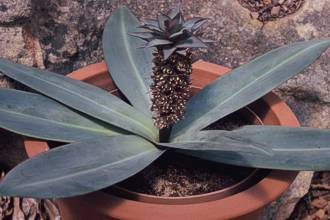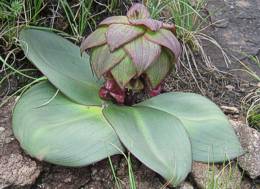Eucomis schijffii
Eucomis schijffii Reyneke
Family: Hyacinthaceae
Common names: miniature eucomis
Introduction
Eucomis schijffii is an alpine bulb with a striking rosette of bluish-grey leaves and a short raceme of purplish-maroon, fetid blooms. It is frost-hardy and makes an interesting and long-lasting summer-flowering container subject or rock garden plant.

Description
Description
This summer-growing, winter-dormant geophyte (a plant with subterranean buds produced on specialised storage organs) is one of the smallest Eucomis species, usually reaching up to 100 mm high, rarely up to 150 mm. It grows from an ovoid (egg-shaped) bulb and has perennial fleshy roots. The 3-5 narrowly to broadly oval leaves are produced in a rosette and have bluish-grey upper surfaces, maroonish undersides, a prominent greenish-yellow midrib and purple, minutely toothed or sometimes curled margins. The very short, narrowly club-shaped scape (flower stem) is deep maroon. The inflorescence is a short raceme (the flowers are stalked and borne along an elongated axis) of long-lasting purplish-maroon, strongly fetid blooms with purple filaments, large yellow anthers and greenish ovaries. Overtopping the inflorescence is a coma or `head' of leaf-like, bluish-grey, suberect, spreading or overhanging bracts that sometimes obscure the uppermost flowers or the entire flower head. The seed capsules have a purple pericarp (fruit wall) and the ovoid, dull blackish-brown seeds have a reticulate (net-like) testa (outer coat). Eucomis schijffii flowers in summer, from December to February, with a peak in January.

Conservation Status
Status
This is a protected species. It is not under threat in the wild and consequently has no conservation status.
Distribution and habitat
Distribution description
Eucomis schijffii is endemic to the Drakensberg Mountains of western KwaZulu-Natal, northern, southern and eastern Lesotho and to the interior mountains of the Eastern Cape. It has the highest altitudinal limit of all Eucomis species, occurring up to 3200 m above sea level. Growing as solitary individuals or in small groups, it frequents lightly shaded, wet basalt (a hard, black volcanic rock) rock faces and open, rocky, grassy fields in basalt gravel. Temperatures regularly fall below freezing in winter and it is a frost-hardy plant, suited to cultivation in areas where winter temperatures do not fall below -5 ºC, and where a dry winter rest period is maintained.
Derivation of name and historical aspects
History
In 1976 the South African botanist W.F. Reyneke named this species in honour of Prof. H.P. van der Schijff, a former Head of the Department of Botany at the University of Pretoria, in recognition of his contribution to the study of the morphology of South African plants.
The generic epithet Eucomis is derived from the Greek eu and komos, meaning `beautifully haired', in this instance alluding to the beautiful or prominent head (coma) of leaf-like bracts that overtop the inflorescence. The colloquial name `Pineapple Flower' that is applied to several Eucomis species, is another allusion to the superficial similarity between the coma bracts of Eucomis and the crown of leaves that develops above pineapple fruits.
Eucomis contains 12 species and is distributed mainly in the summer rainfall eastern and northern parts of South Africa, extending north to Malawi in east central Africa. Its only winter-growing member is the dwarf E. regia, a native of rocky outcrops from Namaqualand in the Northern Cape to Bredasdorp in the southern Western Cape. E. schijffii is most similar to E. grimshawii, another dwarf, high altitude species from the southern Drakensberg, that differs mainly in having very short-lived, sweet-scented, greenish white flowers with white filaments, and light green leaves with hyaline (translucent) margins.
Ecology
Ecology
Eucomis schijffii has strongly fetid flowers and is one of several members of this genus pollinated by carrion flies. The bulbs occur in areas of extreme winter cold but survive these conditions by shedding all their above-ground parts in late autumn and remaining dormant throughout winter. The bulbs are adapted to remain dormant during periods of insufficient summer rainfall. When ripe, the inflated seed capsules split from the top downwards and some of the seeds are dispersed by the shaking action of wind. Subsequently, the scape detaches and the remaining seeds are dispersed as the infructescence (ripe inflorescence) is tumbled about by wind.

Eucomis schijffii growing in habitat Photo: C. McMaster
Uses
Use
No traditional economic or medicinal uses are known for this species. It is used to a limited extent in horticulture as a container subject by specialist bulb collectors and growers of alpine plants, mainly in the Northern Hemisphere.
The most important Eucomis species in ornamental horticulture include the sturdy, greenish yellow-flowered E. autumnalis, the cream-flowered E. comosa and the giant of the genus, the greenish cream-flowered E. pallidiflora that grows up to 2 m high.
Growing Eucomis schijffii
Grow
Grown in ideal conditions, Eucomis schijffii is a long-lived and rewarding plant. The ornamental rosette of bluish-grey leaves with maroonish undersides, and the appealing purplish leaf margins render this species desirable to grow for these characteristics alone. The curious purplishmaroon blooms each last 8-9 days and the developing fruits provide interest for many weeks. The dwarf nature of the plant and its requirement of winter drought preclude it from cultivation in general garden beds that are watered indiscriminately throughout the year, and it is most suitably cultivated as a container plant on a patio or in a cool greenhouse. Its dormant bulbs are frost hardy down to -5 ºC, and in mild climates this species can be grown outdoors in raised, well drained rock garden pockets, but in areas with wet winters, plants are best grown in pots and plunged for the summer, then brought under cover and stored dry in winter. In temperate climates, 200-250 mm diam. plastic pots are ideal but in colder parts, terracotta pots provide better soil aeration. Plant the bulbs in late spring or early summer with the top of the neck 10-20 mm below soil level. They perform well in acid media and a recommended mixture is coarse river sand, finely milled acid bark and sifted acid compost, used in equal proportions.
The plants can be grown in full sun or light shade; the higher the light intensity the more intensely bluish-grey the upper leaf surfaces will be. Apply moisture by drenching heavily once per week throughout summer and early autumn, reducing watering frequency in late autumn and ceasing moisture altogether in winter.
The bulbs are usually solitary and rarely produce offsets, but fresh seeds take about five weeks to germinate. If well grown, seedlings should flower in their fourth or fifth year. Sow the seeds 2-3 mm deep in pots or deep seed trays in spring or early summer, in the same medium recommended for adult bulbs, and allow seedlings to remain undisturbed for three years, before potting them up into permanent containers at the beginning of their fourth summer. It should be possible to propagate this species by basal leaf cuttings: Remove a leaf from the adult plant by holding it firmly at the base and pull it off with a swift tug. Insert the bottom of the leaf about 10 mm deep into a rooting medium such as equal parts of coarse river sand and vermiculite or finely milled bark, and place in a warm and dry, well ventilated area. Keep the medium just slightly moist, not continually wet, as excessive moisture leads to basal rotting. At the end of the summer growing period, the base of the withered leaf cutting should reveal bulblets along the cut surface.
Eucomis schijffii responds well to liquid or slow-release fertilizer applications with high potassium but low nitrogen content. Fertilizers with high nitrogen content tend to result in excessive leaf growth and poor flowering.
The plants are generally pest-free but the bulb scales and leaf bases are susceptible to infestations of mealy bug. The leaves may occasionally be eaten by caterpillars, and the leaf margins are sometimes chewed by nocturnal snout beetles. Fungal rotting of the bulbs occurs in the absence of a sufficiently dry winter dormant phase.
References
- Duncan, G.D. 2007. Lesser-known eucomis. The Plantsman (New Series) 6: 98-103.
- Duncan, G.D. 2010. Grow bulbs. Kirstenbosch Gardening Series. South African National Biodiversity Institute, Cape Town.
- Mathew, B. 1989. Eucomis schijffii. Kew Magazine 6(2): 51-54.
- Pooley, E. 2003. Mountain flowers. The Flora Publications Trust, Durban.
- Reyneke, W.F. 1974. A new species of Eucomis L'Hérit. (Liliaceae) from South Africa. Journal of South African Botany 42(4): 355-360.
- Zonneveld, B.J.M. & Duncan, G.D. 2010. Genome sizes of Eucomis L'Hér. (Hyacinthaceae) and a description of the new species Eucomis grimshawii G.D.Duncan & Zonneveld. Plant Systematics and Evolution 284: 99-109.
Credits
Graham Duncan
Kirstenbosch National Botanical Garden
July 2011
Plant Attributes:
Plant Type: Bulb
SA Distribution: Eastern Cape, KwaZulu-Natal
Soil type: Sandy, Loam
Flowering season: Late Summer
PH: Acid, Neutral
Flower colour: Brown
Aspect: Full Sun, Morning Sun (Semi Shade), Afternoon Sun (Semi Shade)
Gardening skill: Average
Special Features:
Horticultural zones











Rate this article
Article well written and informative
Rate this plant
Is this an interesting plant?
Login to add your Comment
Back to topNot registered yet? Click here to register.